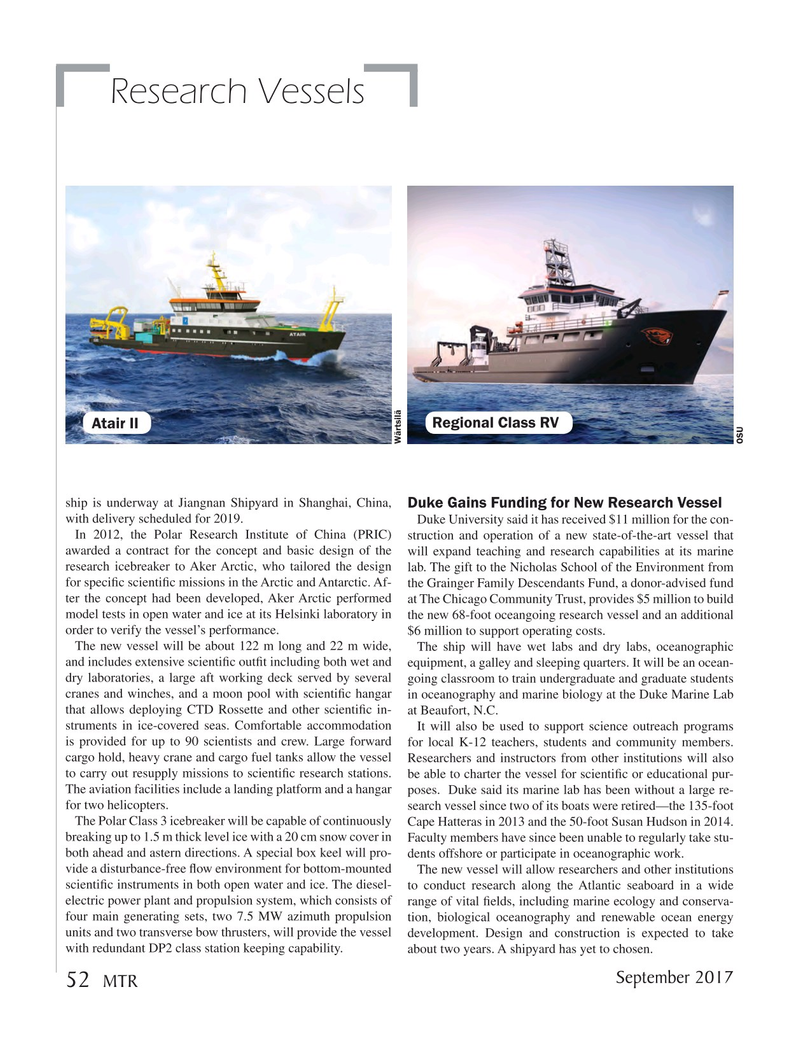
Page 52: of Marine Technology Magazine (September 2017)
Ocean Observation: Gliders, Buoys & Sub-Surface Networks
Read this page in Pdf, Flash or Html5 edition of September 2017 Marine Technology Magazine
Research Vessels
Atair II Regional Class RV
Wärtsilä
OSU ship is underway at Jiangnan Shipyard in Shanghai, China,
Duke Gains Funding for New Research Vessel with delivery scheduled for 2019. Duke University said it has received $11 million for the con-
In 2012, the Polar Research Institute of China (PRIC) struction and operation of a new state-of-the-art vessel that awarded a contract for the concept and basic design of the will expand teaching and research capabilities at its marine research icebreaker to Aker Arctic, who tailored the design lab. The gift to the Nicholas School of the Environment from for speci? c scienti? c missions in the Arctic and Antarctic. Af- the Grainger Family Descendants Fund, a donor-advised fund ter the concept had been developed, Aker Arctic performed at The Chicago Community Trust, provides $5 million to build model tests in open water and ice at its Helsinki laboratory in the new 68-foot oceangoing research vessel and an additional order to verify the vessel’s performance. $6 million to support operating costs.
The new vessel will be about 122 m long and 22 m wide, The ship will have wet labs and dry labs, oceanographic and includes extensive scienti? c out? t including both wet and equipment, a galley and sleeping quarters. It will be an ocean- dry laboratories, a large aft working deck served by several going classroom to train undergraduate and graduate students cranes and winches, and a moon pool with scienti? c hangar in oceanography and marine biology at the Duke Marine Lab that allows deploying CTD Rossette and other scienti? c in- at Beaufort, N.C. struments in ice-covered seas. Comfortable accommodation It will also be used to support science outreach programs is provided for up to 90 scientists and crew. Large forward for local K-12 teachers, students and community members. cargo hold, heavy crane and cargo fuel tanks allow the vessel Researchers and instructors from other institutions will also to carry out resupply missions to scienti? c research stations. be able to charter the vessel for scienti? c or educational pur-
The aviation facilities include a landing platform and a hangar poses. Duke said its marine lab has been without a large re- for two helicopters. search vessel since two of its boats were retired—the 135-foot
The Polar Class 3 icebreaker will be capable of continuously Cape Hatteras in 2013 and the 50-foot Susan Hudson in 2014. breaking up to 1.5 m thick level ice with a 20 cm snow cover in Faculty members have since been unable to regularly take stu- both ahead and astern directions. A special box keel will pro- dents offshore or participate in oceanographic work.
vide a disturbance-free ? ow environment for bottom-mounted The new vessel will allow researchers and other institutions scienti? c instruments in both open water and ice. The diesel- to conduct research along the Atlantic seaboard in a wide electric power plant and propulsion system, which consists of range of vital ? elds, including marine ecology and conserva- four main generating sets, two 7.5 MW azimuth propulsion tion, biological oceanography and renewable ocean energy units and two transverse bow thrusters, will provide the vessel development. Design and construction is expected to take with redundant DP2 class station keeping capability. about two years. A shipyard has yet to chosen.
September 2017 52
MTR
MTR #7 (50-63).indd 52 MTR #7 (50-63).indd 52 8/23/2017 4:37:48 PM8/23/2017 4:37:48 PM

 51
51

 53
53
